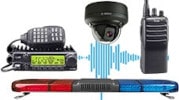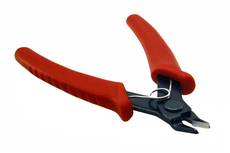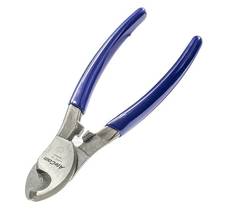- Special Offers
- Transceiver Radio
- Transceiver Accessory
- Antennas
- Antenna Accessory
- Cable
- Connector
- Installation Material
- Installation Tools
- Crimping and Blanking Plier
- Cable Stripper
- Cutting-plier
- Tool Kit
- Cable Extension and Distribution Set
- Soldering Station
- Measuring Equipement
- Body Worn Camera
- Electrosmog
- Telephone
- Baby Monitor
- Fever Thermometer
- Radio Device
- Set-top Boxes
- Personal Protective Equipment
- Motorcycle Helmet Speaker
- Car Equipment
- Voltage Converter
- Dry Cell
- Battery
- Battery Charger
- Emergency Signal
- Amber Signal
- Sound Signal
- Light and Sound Signal Accessory
- Traffic Engineering
- LED Lamp
- Smart Home
- Mosquito Repellent Device
- Market - Other Products
- Discontinued Products
Pre-order (0)
Cutting-plier
Hip tongs are used in a wide variety of places. At home, when carrying out repairs, at work or during hobbies. This type of pliers can be used to cut wires, cables or wires made of different materials, such as plastic or metal. When using the tool, you only need to apply a small amount of force because of the leverage on it. Read more...
Pre-order (0)
• Side cutting pliers
• Hardened steel body with plastic-covered handle
• For use with ~1mm soft wire
• Coax cables: RG-174, RG-58, RG-59, RG-6, H-155
• Length of arms: 12,7cm
• For professional cutting of KOAX cables
• Hardened steel body with plastic-covered handle
• For use with cables up to 8mm outside diameter
• For coax cables: RG-174, RG-58, RG-59, RG-6, H-155
• Length of arms: 16,2cm
There are many different types of pliers, but the most commonly used are side-cutting or cable-cutting pliers. Depending on the tool you choose, they can be used to cut different diameters of wire, cable or wire. If you intend to use the pliers primarily for work, for example as an electrician, make sure that the tool is ESD and/or VDE certified when you buy it. These models offer reliable protection against electrostatic charges and do not transmit electricity up to a certain voltage.
.
What sizes of Cutting-plier are available?
These pliers are used when cutting wire or cable with a diameter of 4.0 mm or more. In order to do this with this type of tool, these versions have a longer handle and a larger head. Therefore, more force can be applied when compressing. Classic pliers are recommended when cutting medium thickness wire or cable between 1.0 mm and 4.0 mm.
But you can also opt for mini pliers when dealing with thin wires or wires with a diameter of less than 1.0 mm. In this case, you can apply much less force as the handle of these tools is short. These pliers are recommended for precision work.
For a comfortable grip and efficient use, how are the Cutting-plier designed?
The weight of the pliers and the length of the handle determine how well the tool fits in your hand. But in all cases, manufacturers design and produce tools that are ergonomically designed to help you work efficiently. Since these types of pliers are operated with one hand, hand resistance and a comfortable grip are not negligible.
The length of the handles also determines the force that can be applied with the pliers. Remember that mini pliers often only have shanks 115 mm or 125 mm long. Standard versions are available with a length of 140 mm or 160 mm. Insulated hip grippers have handles at least 180 mm long.
What to look out for to use pincer grips safely?
Want to take full advantage of all the features of cable cutting pliers? Who wouldn't, because that's why we buy it. However, when using the tool, we must follow the usual safety precautions. This means, first and foremost, that you should not handle the pliers with greasy hands.
Because the tool can slip in your hand and cause injury. Ideally, a side-cutting pliers should have a non-slip grip. If you need to use a lot of force, for example to cut through a thicker wire, we recommend wearing work gloves to avoid minor bruising of the skin and, in the worst case, bruising.
What types of work are hip Cutting-plier recommended for?
Side-cutting or cable-cutting pliers, as their name suggests, are used to pinch or cut certain tools. For example, to cut wires, cables, wires to size. This type of pliers is particularly suitable for this purpose because, when the two handles are pressed together, a balancing effect is created which is transmitted through the head of the pliers to the material to be cut. But why are this type of tool called side-cutting pliers? Because the cutting edges are located on the side of the head.
How durable and long-lasting are these Cutting-plier?
The pliers should be made of the most durable material possible, as you may need them at any time. In fact, professionals use them on a daily basis. Longevity is not only influenced by the quality of the material of the pliers, but also by the maintenance of the tool. This includes regular sharpening of the tool. If you want to sharpen it, use a sharpener or a knife sharpener. This also applies to mini pliers and insulated versions. If possible, choose a stainless steel model because these tools have a smooth surface and are easy to clean if they get dirty.
Do Cutting-plier have to meet any industry or safety standards?
If you have a job where you come into contact with electricity on a daily basis, you need a pincer that is ESD and/or VDE certified. ESD stands for electrostatic discharge. The handle of a pair of pliers with such ESD certification is made of a material that transmits very little electrostatic energy. This is particularly useful if you want to use the side-cutting pliers to perform circuitry tasks, for example on computers. VDE stands for the Association of Electrical and Information Technology Professions.
Only pliers with insulated handles are approved by the association. These tools and pliers can then be used in live electrical equipment. But be very careful to strictly observe the maximum number of voltages specified in the VDE certification, otherwise you put yourself at risk of death.
The right tool is essential to achieve precision work. Check out our range of pliers in the DND webshop!



